Hello, I'm a long-time reader and first-time poster here, thanks for the solid advice over the years.
I'm currently installing a Harman P43 in my home and will be building a hearth. The ideal location for the stove in my home happens to be in a carpeted room and I would like to place the hearth on top of the carpet rather than cut the carpet to avoid any headaches with wrinkles.
I plan to take a 1" sheet of plywood, cut it in half and stack it, then glue/screw the two pieces together. On top of this, I'm going to screw 2 layers of 1/2" HardieBacker, then cement 12" x 12" tiles on top. I realize doubling the plywood may be overkill but because this is going on top of a fairly soft carpet, I want to hearth to be extra strong to prevent cracking when the stove is installed.
My question is: do I also need to screw the plywood down to the floor, or will it be ok "floating" on the carpet with stove on top? Again, my main concern is cracking the tiles or having an unsteady stove. I'd like to build the hearth in the garage first and then float it on the carpet, the whole project would be easier that way, but I'm wondering if I need to first screw the plywood down in place, then finish the build where it sits.
Any advice is much appreciated. Thank you!
I'm currently installing a Harman P43 in my home and will be building a hearth. The ideal location for the stove in my home happens to be in a carpeted room and I would like to place the hearth on top of the carpet rather than cut the carpet to avoid any headaches with wrinkles.
I plan to take a 1" sheet of plywood, cut it in half and stack it, then glue/screw the two pieces together. On top of this, I'm going to screw 2 layers of 1/2" HardieBacker, then cement 12" x 12" tiles on top. I realize doubling the plywood may be overkill but because this is going on top of a fairly soft carpet, I want to hearth to be extra strong to prevent cracking when the stove is installed.
My question is: do I also need to screw the plywood down to the floor, or will it be ok "floating" on the carpet with stove on top? Again, my main concern is cracking the tiles or having an unsteady stove. I'd like to build the hearth in the garage first and then float it on the carpet, the whole project would be easier that way, but I'm wondering if I need to first screw the plywood down in place, then finish the build where it sits.
Any advice is much appreciated. Thank you!



 Happy burning.
Happy burning.